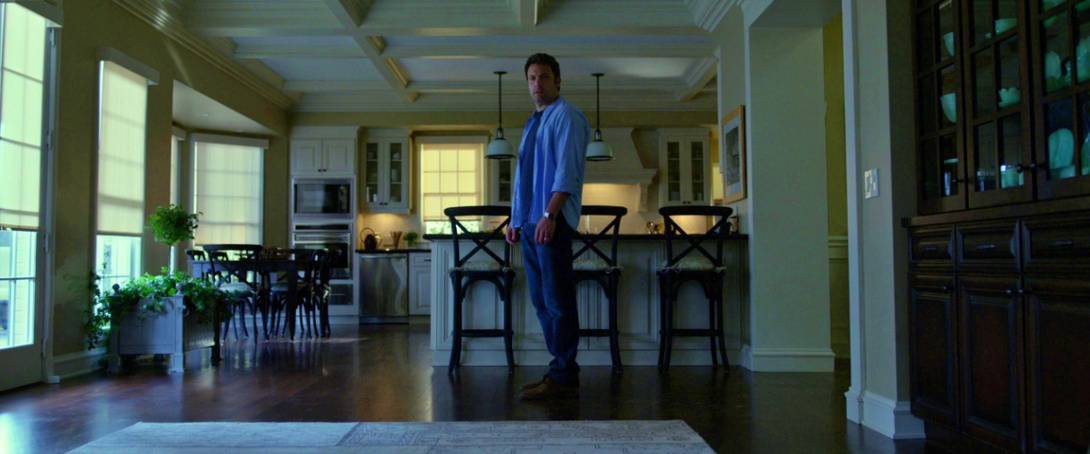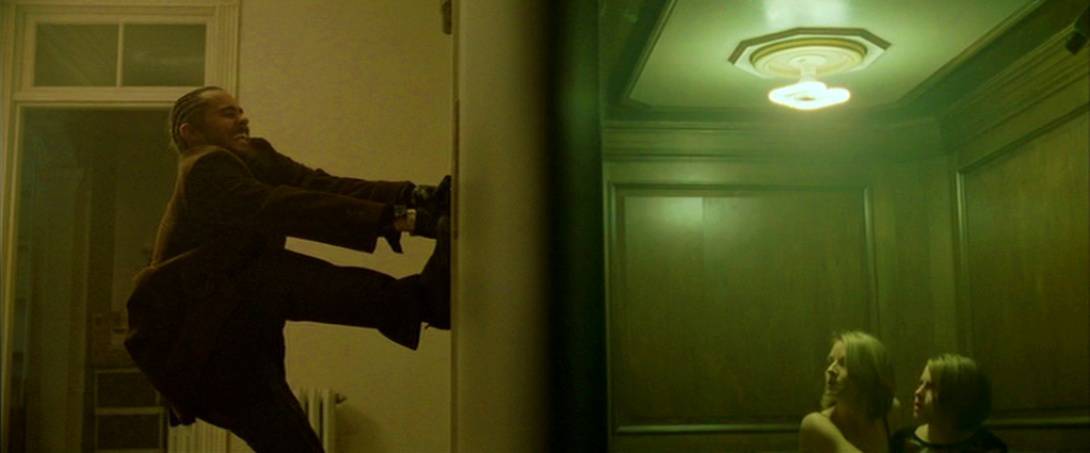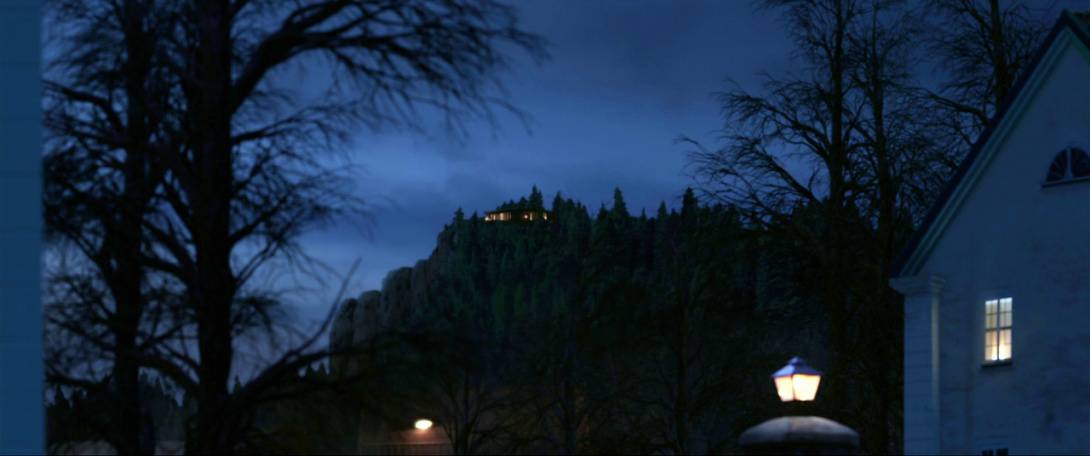There are few directors who can match David Fincher‘s perfectionism in their own craft and fewer still who can match him in reputation. More than perhaps any other director since Stanley Kubrick, Fincher is known for his excruciatingly meticulous dedication to filmmaking. From perfecting minute details with digital retouching to pushing actors with fifty or sixty takes of a scene, Fincher is willing to do whatever is necessary to get it right.
This makes it all the more interesting when Fincher is willing to get it wrong. Eagle-eyed Gone Girl viewers — or anyone who’s watched the movie with the director’s commentary — will notice that there’s something off about the Dunne house. The home that Amy (Rosamund Pike) and Nick (Ben Affleck) share is, much like their marriage, very different from the outside than it is from the inside. Fincher has discussed that when they found the exterior filming location they realized that the interior set, which had already been built, was much bigger than the exterior would allow for. So, Fincher and co. had a decision to make. Do they find a different exterior? Cut back on the already built interior set? Or just go with it?
They went with it. Even though it might not be technically correct, the Dunne’s mishmash of a house registers on a thematic level. It makes sense for Amy and Nick, and the chasm between them as a couple, to have so much empty space to fill that their cat has his own room. But it also contributes to an overall sense of dread that settles in long before the mystery begins to unfold.

Much like the famously impossible architecture of the Overlook Hotel, the Dunne home’s incongruity might not immediately register on a conscious level, but it subtly contributes to the eerieness of Gone Girl right off the bat. Fincher understands how to refine every detail in order to put his audiences on edge or otherwise contribute to tone, and this is illustrated perfectly through his use of locations and houses. Throw a dart at his filmography and you’ll get an example — think of Zodiac‘s improbable California basement, or in Fight Club the acutely hollow furnishings of the Narrator’s apartment — but in addition to Gone Girl, two especially worth singling out are Panic Room and The Girl with the Dragon Tattoo.
Fresh off the whirlwind of Fight Club, Fincher narrowed his scope with Panic Room. The vast majority of the film is confined to a single Upper West Side brownstone. It sprawls upward; five floors serving as a home to newly divorced Meg (Jodie Foster) and her daughter Sarah (Kristen Stewart). The first night they move in, the house is broken into by Junior (Jared Leto), the grandson of the house’s previous owner, Burnham (Forest Whitaker), a morally conflicted security company employee, and Raoul (Dwight Yoakam), a sadistic hitman-for-hire who mostly lurks in the shadows. They’re after bearer bonds left behind in a safe, but there’s one problem: the safe is in the titular panic room, a hidden vault-like room that Meg and Sarah frantically scramble to when they hear the intruders.
Just like that, what was supposed to be the safest room in the house becomes the thing that endangers the mother-daughter pair. David Koepp’s screenplay fully utilizes all of the home-as-a-prison potentials of his premise, but it’s Fincher’s filmmaking that truly kicks the tension into high gear.
The director wastes no time in setting up the dangers of the seemingly innocuous brownstone. When Meg and Sarah first visit with their real estate agent, the tour of the house demonstrates the expansive amount of square footage. The house should feel impressive; it’s on a tree-line Manhattan street, with a renovated interior and floor to ceiling windows. And yet it’s terrifying. Every word spoken inside echoes, an emphasis on how much room exists in the house, how much space exists outside of what can be seen at any give time, how much potential there is for something to go unseen by lurking in a far off corner of the house.
Once Meg and Sarah move in, the mood doesn’t improve. When they turn on the home’s security cameras, the television screens crackle as they come alive. Tinged blue, the all-seeing eyes of the security system are uncanny and unsettling. The cameras and screens should be a comforting measure of protection; instead, they’re impersonal and antiseptic. Not a watchful guardian but an ambivalent spectator. This is complemented by several low angle tracking shots that roam through the house, capturing the environment as vast and imposing empty rooms, ominous in their grandness. Before the break-in, the camera zooms through the house, going through floors and impossible spaces; its omnipresence matching the objective and impersonal perspective of the home security cameras.

Fincher has never been one to pull punches and he’s masterful when it comes to explicit terror, but so much of the genius of his craft comes from the initial set up. It’s imbued into the moments where nothing has gone wrong, but something just feels askew. When the action gets going in Panic Room, the space of the house and the implications that have been with it from the start pay off by not only capturing the anxiety-inducing confines of the panic room, but by utilizing the whole house. When Meg has to make a daring run for the cell phone in her bedroom, the terror comes from what lurks in any one of the many, many corners of the house. Even the cameras have their blindspots and with so much unseen territory, it’s impossible to guess where a threat could be hiding.
Nearly a decade later, Fincher would deploy these same skills for his adaptation of The Girl with the Dragon Tattoo, another film that deftly renders a single space simultaneously claustrophobic and ominously boundless.
When investigative journalist Mikael Blomkvist (Daniel Craig) moves to the fictional Hedeby Island in northern Sweden, he’s there to investigate the island’s inhabitants: the Vanger family. Henrick (Christopher Plummer), the family patriarch, has called him there to parse through the forty-year-old case files pertaining to the disappearance and presumed murder of his grandniece, Harriet. Mikael moves into a homey cottage on the island, surrounded by the larger estate houses, each occupied by a different family member. His search is aided by acerbic hacker Lisbeth (Rooney Mara), the eponymous girl with the dragon tattoo.
In Lisbeth and Mikael’s relationship and their collaborative investigation, the film’s exploration of old melding with new comes to the forefront. He tracks things on foot and pursues leads with a pen and paper. She’s a tech-savvy genius who can get to the bottom of any detail that has ever been put online; as Mara’s Erica Albright says in The Social Network, the internet is written in ink, and sure enough, Lisbeth can find it.
While the two characters exemplify the film’s perspective on the melding of old and new, the locations pointedly capture this as well. The majority of the houses around Mikael are older, stately homes. Their inhabitants range from slightly standoffish to straight-up reclusive; some committed to forgetting the past and others unable to move on from it. As an outsider there to dig up family history, Mikael’s reception among the rest of the Vangers is about as warm as Sweden in December. Except with Martin (Stellan Skarsgard).
Henrick’s nephew and Harriet’s brother, Martin oversees much of the Vanger business and is easily distinguishable from his family in both his cordiality to Mikael and his choice of residence. Above the rest of his family, Martin’s home, modern and made of glass, is perched on a hill. When Mikael first visits Martin for dinner, the house’s sleek interior and warm yellow lighting lie in contrast to the dark woods and howling wind that surrounds the property.
As their investigation unfolds, Mikael and Lisbeth uncover the truth: Martin is a sadistic serial killer. He first aided his father in killing women and abusing Harriet, and when his father died, Martin took over. While Mikael hangs by his neck in a basement dungeon, Martin brags that the night Mikael was over for dinner, he had a woman chained up. His crimes were not exactly hidden in plain sight but they were certainly concealed by the performative openness of both Martin’s disposition and his bright, glass house.

The island itself is much like Martin’s home. As Henrick explains it, when Harriet was a child, the island was safe. It was home for the Vangers, a place where their children could roam with freedom, separated from the dangers of the mainland. Of course, as the plot unfolds, it becomes apparent that the seclusion of the island was, for Harriet, less a promise of safety and more the threat of imprisonment. The island that she called home wasn’t separated from threats, it was the threat, separated from the safety of the outside world. It hardly seems coincidental that the car crash Martin dies in occurs just past the bridge, on the mainland. No longer in the space that has sheltered him for decades, he becomes vulnerable.
And while we’re on the subject of a space going from a safe haven to a prison, the Dunne home isn’t the only interesting location in Gone Girl. Desi’s (Neil Patrick Harris) lakehouse is reminiscent of Martin’s. Sleek, modern, secluded, and outfitted with safety precautions. When Amy feeds him the story of her escape, he takes her there to shield her from Nick, believing the home to be a refuge for her. All Amy sees are security cameras watching her while she plots her next move. While the cameras in Panic Room were bystanders, the cameras here are tools that Amy can manipulate. She can perform injury at just the right angle to be captured on video. It’s an alibi and a motive for her murder of Desi that is afforded an assumption of impartiality because, surely, what is captured on video must be the truth. The camera doesn’t lie, after all.
Fincher also films Desi and Amy within the home with a keen understanding of how incredibly performative their relationship is to Amy. She’s conning him perfectly, play-acting as the demure woman, the victim he saved, so that Desi will let his guard down. When they have breakfast, the two sit at opposite ends of a comically long table. It’s reminiscent of the punchline in Citizen Kane‘s breakfast montage; the distance forged between two people. Of course, the joke here is not that they’ve grown apart, it’s that they never were together, though Amy did a rather amazing job of convincing him otherwise.
Across his films, Fincher deftly utilizes locations for all they’re worth. He uses homes to manipulate expectations, create unnameable feelings of unease, and rack up the tension of any scene. In Panic Room, The Girl with the Dragon Tattoo, and Gone Girl, in particular, Fincher features locations that appear safe. They are mundane suburban dwellings, sleek and modern structures, and they come outfitted with security systems. But on the inside, they are uncanny confines, prisons, and crime scenes waiting to happen. Home might be where the heart is, but in Fincher’s films, that doesn’t mean either is safe.

0 comments:
Post a Comment